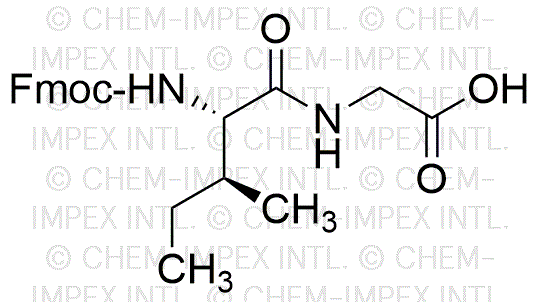Fmoc-Ile-Gly-OH is widely utilized in research focused on:
- Peptide Synthesis: This compound serves as a key building block in the synthesis of peptides, particularly in solid-phase peptide synthesis (SPPS). Its Fmoc protecting group allows for easy removal under mild conditions, making it ideal for constructing complex peptide sequences.
- Drug Development: In pharmaceutical research, it is used to develop peptide-based drugs. The ability to modify the peptide structure enhances the efficacy and specificity of potential therapeutic agents.
- Bioconjugation: Fmoc-Ile-Gly-OH can be employed in bioconjugation processes, linking peptides to other biomolecules or drugs. This is particularly valuable in creating targeted therapies that improve drug delivery and reduce side effects.
- Research in Protein Engineering: It is used in the design of peptide libraries for screening and identifying new protein interactions. This application is crucial in fields like biotechnology and molecular biology.
- Diagnostic Tools: The compound can be integrated into diagnostic assays, enhancing the sensitivity and specificity of detection methods for various diseases, including cancer and infectious diseases.
General Information
Properties
Safety and Regulations
Applications
Fmoc-Ile-Gly-OH is widely utilized in research focused on:
- Peptide Synthesis: This compound serves as a key building block in the synthesis of peptides, particularly in solid-phase peptide synthesis (SPPS). Its Fmoc protecting group allows for easy removal under mild conditions, making it ideal for constructing complex peptide sequences.
- Drug Development: In pharmaceutical research, it is used to develop peptide-based drugs. The ability to modify the peptide structure enhances the efficacy and specificity of potential therapeutic agents.
- Bioconjugation: Fmoc-Ile-Gly-OH can be employed in bioconjugation processes, linking peptides to other biomolecules or drugs. This is particularly valuable in creating targeted therapies that improve drug delivery and reduce side effects.
- Research in Protein Engineering: It is used in the design of peptide libraries for screening and identifying new protein interactions. This application is crucial in fields like biotechnology and molecular biology.
- Diagnostic Tools: The compound can be integrated into diagnostic assays, enhancing the sensitivity and specificity of detection methods for various diseases, including cancer and infectious diseases.
Documents
Safety Data Sheets (SDS)
The SDS provides comprehensive safety information on handling, storage, and disposal of the product.
Product Specification (PS)
The PS provides a comprehensive breakdown of the product’s properties, including chemical composition, physical state, purity, and storage requirements. It also details acceptable quality ranges and the product's intended applications.
Certificates of Analysis (COA)
Search for Certificates of Analysis (COA) by entering the products Lot Number. Lot and Batch Numbers can be found on a product’s label following the words ‘Lot’ or ‘Batch’.
*Catalog Number
*Lot Number
Certificates Of Origin (COO)
This COO confirms the country where the product was manufactured, and also details the materials and components used in it and whether it is derived from natural, synthetic, or other specific sources. This certificate may be required for customs, trade, and regulatory compliance.
*Catalog Number
*Lot Number
Safety Data Sheets (SDS)
The SDS provides comprehensive safety information on handling, storage, and disposal of the product.
DownloadProduct Specification (PS)
The PS provides a comprehensive breakdown of the product’s properties, including chemical composition, physical state, purity, and storage requirements. It also details acceptable quality ranges and the product's intended applications.
DownloadCertificates of Analysis (COA)
Search for Certificates of Analysis (COA) by entering the products Lot Number. Lot and Batch Numbers can be found on a product’s label following the words ‘Lot’ or ‘Batch’.
*Catalog Number
*Lot Number
Certificates Of Origin (COO)
This COO confirms the country where the product was manufactured, and also details the materials and components used in it and whether it is derived from natural, synthetic, or other specific sources. This certificate may be required for customs, trade, and regulatory compliance.


